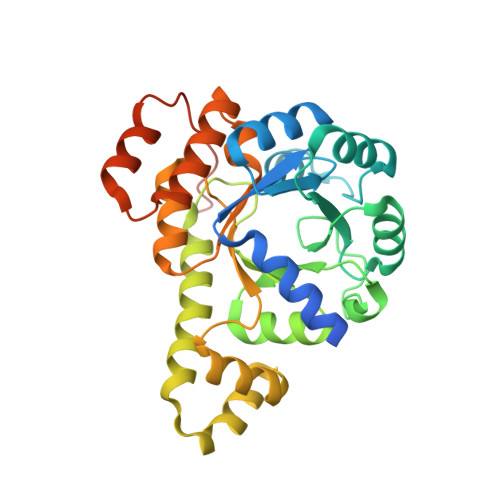Structural definition of the lysine swing in Arabidopsis thaliana PDX1: Intermediate channeling facilitating vitamin B6 biosynthesis.
Robinson, G.C., Kaufmann, M., Roux, C., Fitzpatrick, T.B.(2016) Proc Natl Acad Sci U S A 113: E5821-E5829
- PubMed: 27647886
- DOI: https://doi.org/10.1073/pnas.1608125113
- Primary Citation of Related Structures:
5K2Z, 5K3V - PubMed Abstract:
Vitamin B 6 is indispensible for all organisms, notably as the coenzyme form pyridoxal 5'-phosphate. Plants make the compound de novo using a relatively simple pathway comprising pyridoxine synthase (PDX1) and pyridoxine glutaminase (PDX2). PDX1 is remarkable given its multifaceted synthetic ability to carry out isomerization, imine formation, ammonia addition, aldol-type condensation, cyclization, and aromatization, all in the absence of coenzymes or recruitment of specialized domains. Two active sites (P1 and P2) facilitate the plethora of reactions, but it is not known how the two are coordinated and, moreover, if intermediates are tunneled between active sites. Here we present X-ray structures of PDX1.3 from Arabidopsis thaliana, the overall architecture of which is a dodecamer of (β/α) 8 barrels, similar to the majority of its homologs. An apoenzyme structure revealed that features around the P1 active site in PDX1.3 have adopted inward conformations consistent with a catalytically primed state and delineated a substrate accessible cavity above this active site, not noted in other reported structures. Comparison with the structure of PDX1.3 with an intermediate along the catalytic trajectory demonstrated that a lysine residue swings from the distinct P2 site to the P1 site at this stage of catalysis and is held in place by a molecular catch and pin, positioning it for transfer of serviced substrate back to P2. The study shows that a simple lysine swinging arm coordinates use of chemically disparate sites, dispensing with the need for additional factors, and provides an elegant example of solving complex chemistry to generate an essential metabolite.
Organizational Affiliation:
Department of Botany and Plant Biology, University of Geneva, 1211 Geneva, Switzerland.


















